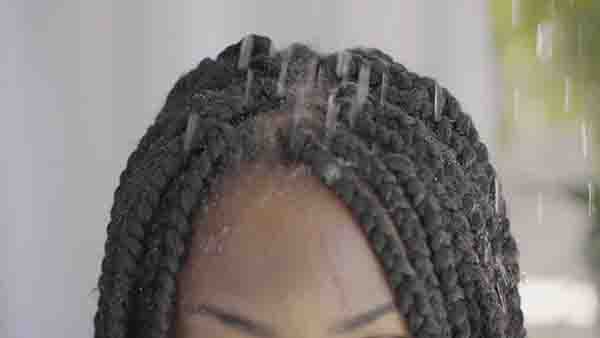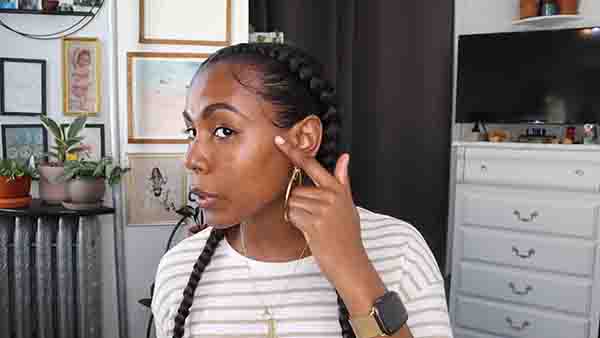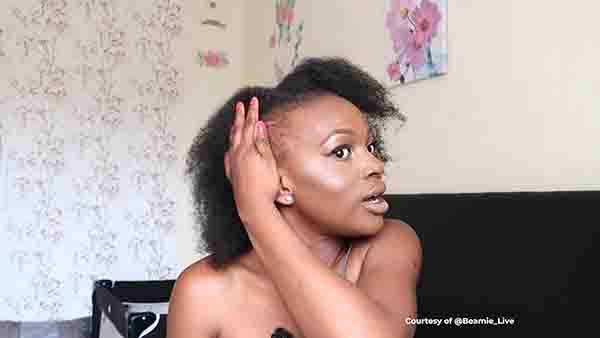Taking a break from protective styles every 4-6 weeks is recommended. During the break, you should wash and deep condition your hair, and reduce the use of heat and styling products.
Protective styles like braids, weaves, and extensions can be a great way to give your natural hair a break from daily styling, but it’s important to know when to take a break from these hairstyles.
Additionally, if you notice any signs of breakage or dryness, it is time to take a break from protective styles.
While they offer convenience and protection, wearing them for extended periods can lead to hair thinning and scalp damage.
We will explore the signs that indicate it’s time for a break from protective styles, along with tips for maintaining the health of your hair during these breaks.
By understanding the importance of taking breaks and practicing proper hair care, you can ensure that your hair remains healthy and strong in the long run.
What Are Protective Styles

Protective styles refer to hairstyles that are designed to protect the hair from damage. These styles involve low manipulation or tucking the ends away, keeping them shielded from external factors. Examples of protective styles include braids, twists, buns, and wigs.
These hairstyles can provide numerous benefits to hair health and growth. First, they help to retain moisture, preventing the hair from becoming dry and brittle.
Additionally, protective styles minimize breakage by reducing friction and tangles. They also promote length retention by preventing the ends of the hair from being exposed to damage.
Furthermore, these styles can give your hair a break from constant styling, heat, and chemical treatments. This break allows the hair to rest and recover, leading to healthier and stronger hair in the long run. Taking regular breaks from protective styles ensures optimal hair health and prevents any potential negative effects.
Signs That It’s Time For A Break

Here are some signs that indicate it’s time to give your hair a rest from protective styles:
1. Dryness
If you notice that your hair is becoming excessively dry and lacks moisture, it’s a sign that your hair might need a break. Dryness can lead to brittleness and breakage over time.
2. Breakage
Excessive breakage is a clear indication that your hair is under stress. Protective styles are meant to prevent breakage, so if you’re experiencing increased hair breakage, it’s time to reevaluate.
3. Thinning
If your hair is thinning or you notice that your edges are receding, it’s crucial to address this issue promptly. Constant tension from protective styles can lead to hair loss and thinning in some areas.
4. Scalp Irritation
If you’re experiencing scalp discomfort, itchiness, or tenderness, it may be a sign of excessive tension or dryness resulting from protective styles.
5. Traction Alopecia
One of the most significant risks associated with protective styles is traction alopecia, a type of hair loss caused by excessive tension on the hair follicles. This can happen if the style is too tight or if the hair is constantly pulled.
6. Changes in Texture
Protective styles should not alter your hair’s natural texture. If you notice that your hair’s texture is changing, becoming frizzy or less defined, it’s time to give your hair a break.
7. Persistent Discomfort
If wearing protective styles becomes consistently uncomfortable or painful, it’s essential to listen to your body and relieve the tension on your hair and scalp.
8. Excessive Shedding
While some shedding is normal, an increase in hair shedding or hair coming out in clumps may indicate that your hair is stressed and needs a break.
What to Do When It’s Time for a Break

When you recognize these signs, it’s essential to act promptly to restore your hair’s health:
- Remove the Protective Style: Carefully remove your protective style to avoid further damage. Be gentle when detangling and handling your hair.
- Deep Conditioning: Give your hair a deep conditioning treatment to replenish moisture and nourishment. Use products specifically designed for your hair type.
- Moisturize: Incorporate a moisturizing routine into your hair care regimen. Use leave-in conditioners and oils to maintain moisture balance.
- Trim Ends: If you notice split ends or damaged tips, consider getting a trim to prevent further damage from traveling up the hair shaft.
- Avoid Tight Styles: When you’re ready to reintroduce protective styles, ensure they are not overly tight and that they do not cause discomfort.
- Regular Maintenance: Keep up with regular maintenance and monitoring of your hair’s health to prevent further issues.
The Impact Of Over-Reliance On Protective Styles
Potential consequences to consider
1. Reduced Hair Manipulation
Protective styles can reduce the need for daily hair styling, which can lead to less breakage and damage. This is especially beneficial for individuals with fragile or brittle hair.
2. Hair Growth
Properly installed protective styles can promote hair growth, as they can help retain length by reducing the risk of split ends and breakage.
3. Prioritizing Scalp Health
Scalp health is integral to maintaining strong and healthy hair. Neglecting proper scalp care can result in itching, inflammation, and other issues that can affect hair growth and quality.
4. Styling Versatility
Protective styles often allow for a wide range of styling options. You can switch between different looks without changing your natural hair, which can be a fun and creative way to express yourself.
5. Environmental Protection
Protective styles shield your hair from environmental factors like harsh weather conditions and pollution, potentially preserving its health.
6. Low Maintenance
These styles often require less daily maintenance compared to constantly manipulating your natural hair, making them convenient for people with busy lifestyles.
Conducting A Hair Analysis

Understanding the current state of your hair is a vital step in making decisions about protective styles and overall hair care. Here’s why assessing your hair’s health is crucial:
1. Hair Density
- Determining Stress Tolerance: Analyzing hair density helps gauge how much tension and manipulation your strands can withstand. If your hair is fine or thin, it may be more susceptible to damage from prolonged protective styles.
2. Porosity
- Hydration Needs: Assessing porosity reveals how well your hair retains moisture. Low-porosity hair may require different hydration practices than high-porosity hair. Understanding porosity allows you to incorporate appropriate moisturizing techniques to keep your hair healthy.
3. Elasticity
- Overall Health Indicator: Elasticity assessment shows your hair’s ability to stretch and return to its natural state without breaking. Healthy hair should have good elasticity. If your hair lacks elasticity, it may be a sign of damage or moisture imbalance.
4. Informed Decisions
- Tailored Hair Care: Conducting a thorough hair analysis empowers you to make informed decisions about protective styling and hair care practices. You can tailor your routine to address your specific hair needs and concerns.
5. Long-Term Benefits
- Prioritizing Hair Health: Prioritizing your hair’s health above all else is essential for long-term hair vitality. Making decisions based on your hair’s current condition ensures that you’re taking the best possible care of your strands.
Consulting A Professional Stylist

Finding a stylist experienced in natural hair care and protective styles is crucial. Discuss your concerns and goals with the stylist to receive personalized recommendations. Seeking professional advice is advantageous, as it allows you to evaluate your hair’s condition effectively.
By consulting a professional stylist, you can ensure that your protective styles are not causing any damage or stress to your hair. They can identify any potential issues and provide suitable solutions for your specific needs. Additionally, a professional stylist can give you insights on how to maintain and care for your hair while wearing protective styles.
Trusting the expertise of a professional can help you make informed decisions about when to take breaks from protective styles, ensuring the optimal health and condition of your hair.
Listening To Your Hair’s Needs
Listening to your hair’s needs is crucial, especially when you’re using protective styles. Protective styles are meant to help your hair retain moisture, reduce manipulation, and minimize damage, but they still require attention and care. Here are some tips for listening to your hair’s needs while using protective styles:
1. Preparation and Maintenance
Before getting a protective style, ensure your hair and scalp are clean, moisturized, and in good condition.
Regularly cleanse your scalp with a gentle, sulfate-free shampoo to prevent buildup.
Moisturize your natural hair and scalp as needed, paying attention to your hair’s moisture preferences.
2. Regular Inspection
Periodically inspect your scalp and hair while wearing the protective style to check for any issues like itching, dryness, or irritation.
Be vigilant for any signs of hair breakage or damage.
3. Moisturize and Oil Your Scalp
Use a lightweight oil or scalp moisturizer to keep your scalp hydrated without causing buildup.
Apply oils sparingly to your scalp using a nozzle applicator to reach beneath your protective style.
4. Protective Style Duration
Avoid keeping protective styles in for extended periods. Ideally, aim for 4-6 weeks at most, then give your hair a break.
Listen to your hair’s signals. If it feels like it needs a break sooner, take the style down.
5. Wash Your Protective Style
Some protective styles, like braids or twists, can be washed while installed to maintain cleanliness and reduce odor.
Use a diluted sulfate-free shampoo and focus on your scalp, then rinse thoroughly.
6. Maintain a Healthy Diet
Proper nutrition and hydration play a significant role in the health of your hair. Consume a balanced diet rich in vitamins, minerals, and protein.
7. Protective Style Removal
Be gentle when removing your protective style to minimize hair breakage.
Follow a proper detangling and conditioning routine after removing the style.
Hydration And Moisture Retention

Taking a break from protective styles allows your hair to breathe and rejuvenate. Hydration and moisture retention are essential during this time. Deep conditioning and moisturizing play a significant role in maintaining hair health. By using suitable products and methods, you can effectively keep your hair hydrated.
Regular deep conditioning treatments and incorporating moisturizers in your hair care routine are crucial. Look for products rich in natural ingredients, such as shea butter and coconut oil, to nourish your hair. To retain moisture, choose leave-in conditioners and oil-based treatments.
These will help prevent dryness and breakage. Remember, proper hydration is key for maintaining healthy hair during breaks from protective styling. Prioritize nourishing and moisturizing your locks to promote hair growth and prevent damage.
Gentle Styling Alternatives
Taking breaks from protective hairstyles is essential for maintaining the health and growth of your hair. Instead of subjecting your hair to prolonged stress, explore gentle styling alternatives. Low-manipulation hairstyles are a great option as they minimize tension on your hair strands.
By opting for these styles, you can ensure that your hair remains healthy and doesn’t experience any breakage or damage. These alternatives provide a much-needed respite to your hair, allowing it to rejuvenate and grow without strain. So, the next time you feel like giving your hair a break, consider gentle styling options that promote hair health and growth.
Consistency And Balance
Consistency and balance are key when it comes to maintaining healthy hair. It’s important to establish a sustainable haircare routine that includes both protective styling and breaks. By finding the right balance, you can enjoy the benefits of protective styles while still giving your hair the rest it needs.
Long-term strategies for healthy hair should include regular breaks from protective styles to prevent damage and promote growth. These breaks allow your hair to breathe, reducing the risk of breakage and maintaining the overall health of your hair.
While protective styles are great for minimizing manipulation and promoting length retention, taking breaks is essential for the long-term health of your hair.
So, don’t forget to give your hair the break it deserves and enjoy the benefits of a well-balanced haircare routine.
Related Articles:
- Can I Braid My Hair After Dying It
- Does Braids Stop Shrinkage
FAQ
Yes, taking breaks between protective styles allows your hair to recover and minimizes the risk of damage from constant manipulation.
Yes, giving your hair a break between box braids helps maintain scalp health and prevents over-tightening and breakage.
After removing protective styles, deep condition, detangle gently, and moisturize your hair to restore its health and vitality.
Avoid over-tightening, excessive pulling, and neglecting scalp care when wearing braids to prevent damage and breakage.
Yes, knotless braids can be a protective style when installed and maintained properly to safeguard your natural hair.
No, protective styles should not damage your hair when applied and cared for correctly; they should promote growth and health.
Yes, sleeping in braids can reduce breakage by minimizing friction and tangling, preserving your hair’s strength.
Wash your hair with protective styles every 1-2 weeks or as needed to keep your scalp clean and maintain moisture.
Wait several weeks between braiding styles to let your hair recover and avoid excessive stress on your scalp.
After removing a protective style, focus on deep conditioning, moisturizing, and gently detangling your hair to restore its health.
Spraying locs with water daily can help maintain moisture, but avoid over-saturating, which may lead to mold or mildew.
Locs do not need to be taken out unless you want to remove them entirely. They require regular maintenance but not removal.
You can style locs as often as you like, but avoid excessive manipulation to prevent breakage.
It can take several months to a year or more for dreads to fully lock, depending on your hair type and maintenance.
There’s no specific length for dreads; they can be started at various lengths, but longer hair often forms dreads more easily.
Braids can damage locs if they are too tight or not removed carefully, so it’s essential to handle them with care.
Dry locs may feel brittle, rough, or look dull. Regular moisturizing and conditioning can prevent this.
Braids, when done correctly, should not be damaging. However, improper installation and excessive tension can lead to damage and breakage.
Wearing a braid every day can cause tension and potential breakage. It’s advisable to give your hair breaks between braided styles to maintain its health.
Conclusion
Taking breaks from protective styles is crucial for maintaining healthy hair and scalp. While protective styles can help protect your hair from damage, they also create tension and stress on your strands. By recognizing the signs of breakage, dryness, or scalp issues, you can determine when it’s time to give your hair a break.
It’s recommended to take breaks between protective styles, preferably every 4-6 weeks, to allow your hair to breathe and rejuvenate. During these breaks, focus on proper hair care, deep conditioning, and nourishing your scalp. Additionally, incorporating low-manipulation styles and protective hairstyles that are gentle on your hair can help prevent breakage and promote healthy hair growth.
Remember that everyone’s hair is different, so listen to your hair and cater to its specific needs. By finding a balance between protective styling and regular breaks, you can maintain healthy, beautiful hair in the long run.

